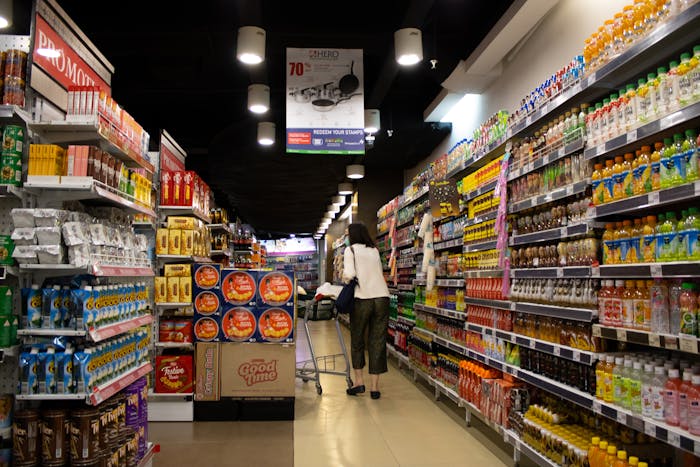If your business has some shelves empty while others are overflowing, you may need to adjust how you set the reorder points for your merchandise. This could help balance your inventory more effectively.
Calculating your reorder point correctly is crucial for profitability. This is especially true in low-margin industries such as grocery, home furnishings, or alcohol sales. Setting the right reorder level helps avoid running out of stock. It also reduces costs by minimizing unnecessary inventory storage and product expiration.
We'll help you calculate the reorder point for your merchandise to align inventory with customer demand. This helps keep sales consistent and reduces unnecessary expenses by avoiding premature reordering of inventory.
Understanding Reorder Point
The reorder point is the inventory threshold that signals when it's time to reorder a product. It represents the minimum stock level needed to meet customer demand until new inventory arrives.
When inventory reaches this point, either your warehouse management system (WMS) automatically generates an order or managers place one manually.
For example, if you owned a pharmacy and the reorder point for a bottle of aspirin was 10, you would need to reorder aspirin when there were 10 bottles left in stock.
The Importance of Reorder Points
Understanding and using reorder points can revolutionize how you manage inventory across your supply chain. Maintaining sufficient stock levels is crucial for customer satisfaction and minimizing profit loss.
Avoiding Stockouts
Setting and monitoring your reorder point ensures that products don't run out before customers have a chance to buy them. Failing to reorder at the right time can disappoint customers who come to your store expecting to make a purchase, only to find empty shelves.

If your reorder point for aspirin is 10, waiting until you have only five bottles left before contacting your supplier will lead to a stockout, meaning you run out of stock. This might cause customers to buy a different product if available, potentially losing their business to a competitor.
Consumers lack patience; they will cancel their orders and seek alternatives elsewhere
Based on research from Statista, a significant portion of consumers, if faced with extended delivery times due to stock shortages, are likely to cancel their purchase orders and seek alternatives elsewhere.
If your inventory runs out and customers face extended wait times of a week or more, they are likely to cancel their orders and find what they need elsewhere. This scenario often leads to lost sales and potential customer dissatisfaction. One of the primary reasons businesses lose customers is their failure to establish clear expectations about realistic timeframes and the level of effort customers will need to invest.
Preventing Profit Loss
Another key reason why the reorder point is important is to prevent profit loss. Placing orders too early can lead to excess stock accumulation, which in turn can impact profitability.
Storing excessive inventory for extended periods results in increased expenses. That is due to costs such as space, insurance, taxes, and inventory deterioration. This prolonged warehousing of merchandise can significantly reduce profit margins. Additionally, for products with a limited shelf life, such as food, if they expire before being sold, it leads to financial loss. Namely, the investment made to get the products will not be recovered.
Calculating the Reorder Point
Average Daily Usage X Lead Time = Reorder Point
To calculate the reorder point, you multiply the average daily usage by the lead time.
Let's apply the reorder point formula to calculate the reorder point for a grocery store selling orange juice.
Average Daily Usage
To determine the average daily usage of orange juice, store managers add up the total number of orange juice bottles sold over a specific period, such as 30 days. They then divide the total number of sales (e.g., 300 bottles) by the number of days in the period (30 days). This calculation yields an average daily usage of 10 bottles of orange juice.
Lead Time Definition
Lead time is the duration it takes for orange juice to arrive at the store after it's been ordered from the supplier. For instance, if it typically takes three days for orange juice to be delivered from the supplier to the store after placing an order, the average lead time is three days.
Calculating Reorder Point
To calculate the reorder point for orange juice, multiply the average daily usage (10 bottles) by the lead time (3 days). This means that when the grocery store's stock of orange juice reaches 30 bottles, it's time to place a new order. This is done to ensure they have enough inventory to meet customer demand.
Understanding the Complexity of Reorder Point
Determining the reorder point may appear straightforward for a single product. However, it becomes more intricate as you manage larger inventories. Each product you sell could have unique lead times and average daily usage, adding complexity to the calculation process.
Another factor that adds complexity is seasonality. Namely, certain products experience fluctuating average daily sales based on the time of year. For example, demand for orange juice tends to increase during flu season. So, you'll need larger order quantities to maintain appropriate inventory levels. Failing to incorporate seasonal variations into your average daily usage calculation can lead to potential stockouts.
Moreover, increased demand for orange juice across many businesses can strain the supply chain. That can potentially cause delays in delivery times. To mitigate the risk of stockouts, businesses should maintain safety stock levels. Incorporating safety stock into inventory management may require adjustments to the reorder point (ROP) formula.
Real-Life Example of Reorder Point Calculation and Its Benefits
Dawn Rosch, a former Veterinary Economics Practice Manager of the Year, used reorder points to optimize inventory management at a veterinary clinic. They applied this approach to essential medicines, setting a reorder point based on a hypothetical maximum lead time of 30 days. They did that even though actual delivery times were typically shorter, around 24 hours.
This strategy ensured that critical supplies were always available without excess inventory, freeing up capital for other investments. By reducing order quantities and increasing order frequency, the clinic decreased its medicine inventory from $125,000 to $90,000 on hand at any time.
This improvement provided the clinic with an extra $35,000 in available capital for marketing, hiring new staff, renovations, and other business enhancements. The reallocation of resources demonstrates the value of efficient inventory management over holding unnecessary stock.
Using Inventory Management Software for Enhanced Efficiency and Cost Savings
Instead of manually calculating reorder points or relying on Excel formulas, leveraging inventory management software offers a more effective solution. Managing inventory with varying daily usage, lead times, and product seasonality can be challenging without automation. Software streamlines these processes, ensuring optimal stock levels and efficient inventory control.
Benefits of Using Inventory Management Software:
- It enhanced reliability. Minimizes the risk of human error in calculations, preventing overstocking or understocking.
- It saves costs. Optimizes inventory levels to reduce unnecessary carrying costs.
- It improves customer experience. Ensures merchandise availability on shelves, meeting customer demand.
- It has budget-friendly options. Software solutions available for businesses of all sizes and budgets.
- It is time-saving. Automates inventory management processes, increasing efficiency and freeing up resources for other tasks.
If your business provides delivery services, which is highly recommended due to increased demand, using route management software can save you time and money. This software automatically calculates the most efficient routes to cut mileage. By integrating your inventory management software with route management software using an API, you can enhance efficiency. It will also help you further reduce costs throughout your business operations.
Reduce Delivery Costs with eLogii
Whether you run a meal delivery service with tight profit margins or an independent pharmacy focused on timely medication delivery, eLogii's route management software can enhance delivery efficiency and lower your operational expenses.
Discover how eLogii's features can help your business save money:
- Simplify route planning. Upload your data, and eLogii instantly calculates optimized routes. It considers variables like time windows, order load, and stop duration, reducing the need for extensive manual planning.
- Reduce fuel costs and mileage. eLogii generates the most efficient routes for drivers. It minimizes backtracking and lowers gas expenses by reducing mileage.
- Cut driver overtime. Use eLogii to calculate allowed working hours, helping you manage and reduce driver overtime expenses.
- Improve efficiency over time. Analyze eLogii's route analytics to identify areas for improvement, enhancing efficiency and reducing delivery times.
Deanta's Automated Delivery Success with eLogii (Saving Six Figures!)

Deanta is a UK-based company specializing in distributing high-quality interior doors for over 20 years. They take pride in their quick and efficient distribution of products across the country.
Due to its remarkable growth of over 50% in its business, it led to increased nationwide distributions. As manual routing and outdated route planning systems proved inadequate, Deanta's team recognized the urgent need for more effective distribution management.
Deanta's team then chose eLogii as their preferred route planning and optimization software.
With better efficiency, Deanta was able to make six-figure savings and a 79% reduction in planning time.
Discover Cost Savings with eLogii
Handling your business requirements manually, whether it's inventory management or delivery route planning, can lead to costly errors that impact your profits. By leveraging software solutions like eLogii, you can save time, improve efficiency, and boost your bottom line.
